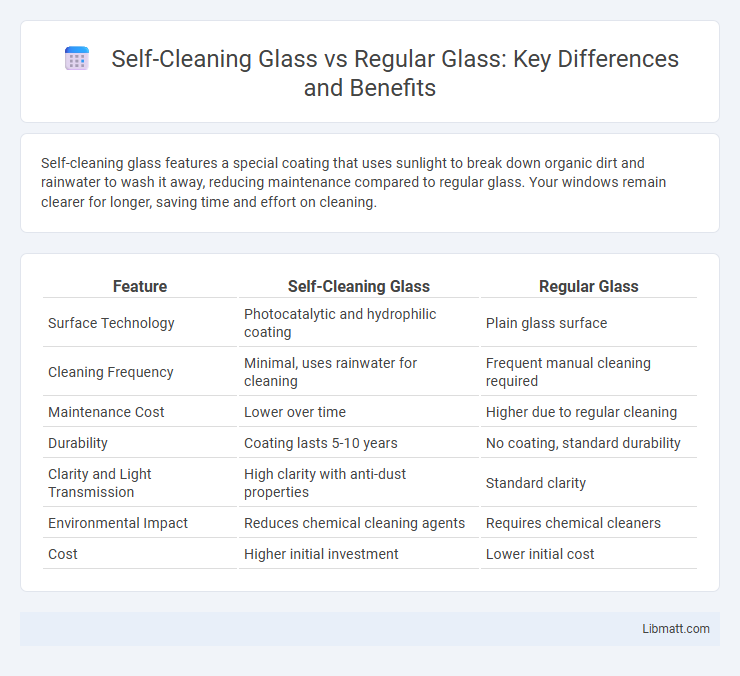Self-cleaning glass features a special coating that uses sunlight to break down organic dirt and rainwater to wash it away, reducing maintenance compared to regular glass. Your windows remain clearer for longer, saving time and effort on cleaning.
Table of Comparison
| Feature | Self-Cleaning Glass | Regular Glass |
|---|---|---|
| Surface Technology | Photocatalytic and hydrophilic coating | Plain glass surface |
| Cleaning Frequency | Minimal, uses rainwater for cleaning | Frequent manual cleaning required |
| Maintenance Cost | Lower over time | Higher due to regular cleaning |
| Durability | Coating lasts 5-10 years | No coating, standard durability |
| Clarity and Light Transmission | High clarity with anti-dust properties | Standard clarity |
| Environmental Impact | Reduces chemical cleaning agents | Requires chemical cleaners |
| Cost | Higher initial investment | Lower initial cost |
Introduction to Self-Cleaning and Regular Glass
Self-cleaning glass features a special photocatalytic coating that breaks down organic dirt when exposed to sunlight, reducing maintenance requirements. Regular glass lacks this coating, necessitating frequent manual cleaning to maintain clarity and appearance. The innovative properties of self-cleaning glass improve durability and energy efficiency in architectural applications.
How Self-Cleaning Glass Works
Self-cleaning glass utilizes a photocatalytic coating, typically titanium dioxide, which activates under sunlight to break down organic dirt on the surface. When exposed to UV light, this coating triggers chemical reactions that decompose grime into water-soluble particles. Rainwater then easily washes away these particles, reducing the need for manual cleaning compared to regular glass.
Composition and Structure Differences
Self-cleaning glass incorporates a titanium dioxide (TiO2) coating that reacts with sunlight to break down organic dirt through photocatalysis, whereas regular glass lacks this functional layer. The micro-structured surface of self-cleaning glass enhances hydrophilicity, allowing water to spread evenly and wash away debris easily, contrasting with the smooth surface of conventional glass that retains dirt and water spots. These compositional and structural differences result in significantly reduced maintenance and improved clarity for self-cleaning glass compared to standard glass panes.
Cleaning and Maintenance Requirements
Self-cleaning glass reduces cleaning frequency by utilizing a special photocatalytic coating that breaks down organic dirt when exposed to sunlight, allowing rainwater to wash it away effortlessly. Regular glass requires manual cleaning with detergents and scrubbing to remove dirt, grime, and water spots, demanding more time and effort. Choosing self-cleaning glass lowers your maintenance needs and ensures clearer windows with minimal upkeep.
Cost Comparison: Self-Cleaning vs Regular Glass
Self-cleaning glass typically costs 20-30% more upfront than regular glass due to its specialized coatings that break down dirt and reduce cleaning frequency. Over time, the reduced need for manual cleaning and maintenance can offset the higher initial expense, especially in hard-to-reach or large window installations. Your long-term investment in self-cleaning glass often results in lower maintenance costs, making it a cost-effective option compared to traditional glass.
Durability and Longevity
Self-cleaning glass features a durable photocatalytic coating that actively breaks down organic dirt and repels water, extending its lifespan beyond that of regular glass. This advanced coating reduces the need for abrasive cleaning, preserving the glass surface and maintaining clarity over time. Your investment in self-cleaning glass ensures longer-lasting performance and less frequent replacement compared to standard glass options.
Environmental Impact and Sustainability
Self-cleaning glass reduces the need for chemical cleaning agents and frequent water usage, significantly lowering its environmental footprint compared to regular glass. Its photocatalytic coating breaks down organic dirt using sunlight, promoting sustainability by minimizing maintenance resources and extending the glass lifespan. This technology supports energy efficiency by enhancing natural light transmission and reducing reliance on artificial lighting.
Application Areas: Where Each Type Excels
Self-cleaning glass excels in building facades, skylights, and solar panels by reducing maintenance efforts and enhancing durability through its hydrophilic and photocatalytic properties. Regular glass remains preferred in applications where cost sensitivity is crucial or where manual cleaning is easily manageable, such as interior windows and decorative installations. Industrial and commercial sectors benefit from self-cleaning glass to maintain clarity and performance without frequent cleaning, while residential applications often balance between both types based on location and budget.
Pros and Cons of Self-Cleaning Glass
Self-cleaning glass features a special coating that breaks down organic dirt and allows rainwater to wash it away, significantly reducing maintenance time compared to regular glass. Its advantages include enhanced durability, improved visibility, and reduced cleaning frequency, while drawbacks encompass higher initial cost and potential coating degradation over time. Choosing self-cleaning glass can offer your property long-term savings and a cleaner appearance, but evaluating the upfront investment and specific environmental conditions is essential.
Choosing the Right Glass for Your Needs
Self-cleaning glass uses a special titanium dioxide coating that breaks down dirt and allows rainwater to wash it away, reducing maintenance compared to regular glass. Regular glass requires frequent cleaning to maintain clarity, which can demand more time and effort, especially in hard-to-reach areas. Choosing the right glass for your needs depends on factors like budget, building location, and long-term maintenance preferences, making self-cleaning glass ideal for minimizing upkeep in urban or dusty environments.
self-cleaning glass vs regular glass Infographic

 libmatt.com
libmatt.com